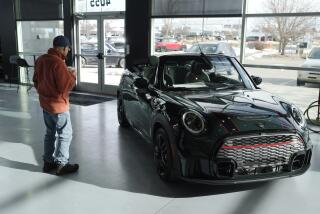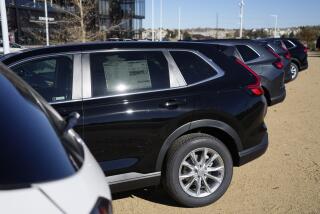Imports Making Inroads in Big 3 Auto Territory
These should be heady times for the traditional U.S. Big Three auto makers. Coming off a year of record industrywide sales, they are still selling vehicles at a fast enough clip to rack up their third-biggest year in history, even in the face of a prolonged national economic downturn.
But as the companies prepare to announce July sales Wednesday--and total up all those loyal Chevy, Ford and Dodge buyers--they still have to contend with folks such as Jeff and Lynn Johnson.
When the Corona couple were ready to move up from their mid-size sport-utility vehicle to a full-size model, Jeff thought the Chevrolet Suburban was looking pretty good.
“I wanted to go with an American truck because the prices had come down substantially, to around $32,000,” said Johnson, 40, a state Department of Forestry fire captain.
Nevertheless, Lynn talked her husband into cashing in an inheritance and buying Japanese--specifically a $40,000 Sequoia, the burly SUV that Toyota Motor Corp. put on the market in November.
“All my girlfriends were driving these big mondo trucks like Chevy Tahoes,” said Lynn, also 40 and a hairstylist and longtime Toyota owner. “But I want dependability. I trust my vehicle and wouldn’t want to be stranded. Plus, it has high resale value and low maintenance, and it will run forever.”
That kind of talk spooks Chevy maker General Motors Corp. and Big Three rivals Ford Motor Co. and the U.S. arm of DaimlerChrysler. The Detroit-area companies have long been losing market share in small and mid-size passenger cars to Asian brands, but are accustomed to having their way in the highly profitable light-truck market.
Importers led by Toyota, Nissan Motor Co. and Honda Motor Co. are scarfing up market share in light trucks--minivans, SUVs and pickups--particularly in the largest models, long an exclusively American domain. Toyota is expanding its Indiana factory to churn out more full-size Tundra pickups and Sequoias, as well as a new minivan; Nissan is building a huge plant in Mississippi for its first large pickup and SUV; and Honda has broken ground in Alabama for a plant to build more Odyssey minivans and a new SUV.
“The Japanese new-product threat is not just serious--it’s worse than that,” said John Casesa, senior auto industry analyst for Merrill Lynch. “These companies are entering a new stage of growth in the U.S. market, driven by their transformation into full-line producers of American-style vehicles with a tidal wave of new trucks. . . . For domestic U.S. investors, this is a huge threat.”
It’s not just trucks. This fall, Toyota is coming out with an all-new version of its Camry--the best-selling passenger car in the country--and Nissan with a more powerful Altima, both of which have industry watchers drooling. Honda also is planning to redo entirely its ever-popular flagship Accord for 2003.
“The next generation of Japanese passenger cars will be dramatically more appealing than the current generation,” Casesa said, using words such as “astounding” to describe the importers’ gains, while dismissing the passenger-car businesses of GM, Ford and Daimler’s Chrysler Group as “the soft underbelly of the Big Three.”
Amid a declining economy that creaked to a virtual standstill in the second quarter, sales at Ford, the best-selling nameplate in the country, declined 10.5% in the first six months of the year. GM saw sales at Chevy, the No. 2 brand, fall 3.4% and its luxury marque Cadillac drop 18.8%. Daimler’s Dodge was down 13.9%. The list goes on.
Granted, the U.S. auto market has contracted 4.6% this year and is expected to fall about 1 million vehicles short of last year’s superheated sales of 17.4 million new cars and light trucks.
But even in a down market, the good news kept clicking for many import brands. Toyota’s sales grew 5% in the first six months of this year, allowing the No. 1 Japanese auto maker to boast of its best-ever first half in 44 years of doing business in the States.
Honda recorded its second-best month of U.S. sales in June, while its luxury division Acura posted an eighth consecutive month of record sales, which leaped 25.4% from January to June. Mazda Motor Corp. of Japan was up 12.9%, BMW of Germany 20.8%. South Korean auto maker Hyundai Motor Co. and its Kia Motors affiliate continued to surge, with sales rising 33.3% and 36.4%, respectively, in the first half.
The diverging fortunes of the Big Three and the importers come as no surprise to James Hossack, a senior analyst with industry consultant AutoPacific in Tustin.
He describes the Big Three as “absolute experts on making lowest-common-denominator vehicles,” saying, “They have the minimum of everything that meets the law. They start when you turn on the key, they stop at the signal, the radio plays, the air conditioner cools things off. They are all competitive, but they are not great at anything.
“But when BMW says it is the ultimate driving machine and Mercedes says it is engineered like no other and Toyota says it is reliable and durable and Honda says it is fun, those statements are all true. And if you are going to spend money on a car, and have it to spend, then why not get something you want, which is what the imports provide, instead of just something you need?”
Not everyone in Detroit is buying such doom-and-gloom scenarios.
“Among the domestics, we’re not in the same boat,” said Paul Ballew, GM’s chief market analyst. Though well below historic highs, the company’s market share is stabilizing; GM is doing well with trucks, he said, while shoring up its position in small and mid-size cars.
Indeed, sales of GM’s compact Chevrolet Cavalier and Prizm have risen this year, along with those of the mid-size Saturn L-Series and Oldsmobile Aurora sedans and full-size Chevy Impala. In trucks, GM posted improved sales of its GMC Yukon and Chevy Tracker, Tahoe and Suburban SUVs, as well as its Chevy Silverado large pickups.
“We’ve become reestablished with educated and dual-income households--groups we’ve lost touch with in the last 10 to 15 years,” Ballew said.
Similarly, Gurminder Bedi, Ford’s vice president for North America trucks, brushes aside talk of weakness, even as sales of every Ford car and truck model except the all-new Escape SUV have declined this year.
“We have the best-selling subcompact SUV in the Escape,” Bedi said, noting that it has overtaken the Honda CR-V in that segment. “We have the best-selling mid-size SUV, the Explorer. We have the best-selling compact pickup and the best-selling full-size pickup,” he said, referring to the Ranger and F-Series trucks, respectively.
Chrysler Group has sold more cars year-over-year, thanks to the retro PT Cruiser and an expanded Sebring lineup, but sales of Dodge and Jeep trucks have plunged.
The lone bright spot is the Jeep Liberty, just coming to market to replace the aging Cherokee SUV.
“Liberty is proving to be a major success,” said Gary Dilts, Chrysler Group’s senior vice president for sales. “Liberty is doing for Jeep dealers what PT Cruiser did for our Chrysler dealers, creating traffic and excitement.” Chrysler executives have similar hopes that the newly redesigned Ram pickups will jump-start sales, which are down 12.5% this year.
For the rest of the year, analysts are forecasting a tighter market and, with it, more competitive pressures on all the major auto makers, even the highflying importers.
Although June U.S. auto sales grew 0.3% from a year earlier, Merrill Lynch’s Casesa predicts a 4% decline in the July sales to be announced Wednesday.
“As the Big Three step up incentive spending, the recent strength of non-Big Three sales will wane in July with sales up just 1% to 1.5%,” he said. Other analysts say Toyota and Honda could even register declines for July. Amid such market softness, even Toyota is getting deeper into the discount strategy. Though the auto maker already offered regional incentive programs, it also has instituted nationwide discounts in recent months of up to $1,000 on certain models in stock.
“It was surprising to us that Toyota put cash on the hood,” said Bill Lovejoy, GM’s vice president for sales, service and marketing. “I’ve never seen that before.”
In the end, having the major auto makers battling across more market segments for somewhat fewer buyers can only add up to gains for shoppers.
“I think we’ll see the domestics attack the Europeans and Japanese with sport wagons and luxury crossovers,” said analyst Jeff Schuster of J.D. Power & Associates in Troy, Mich. “It’s good news for the consumer: more choices and more products addressing their needs.”
Times staff writer John O’Dell contributed to this report.
(BEGIN TEXT OF INFOBOX / INFOGRAPHIC)
More Trucks Ahead
Japanese auto makers are switching over their factory capacity in Canada and the U.S. to build more high-profit trucks, further squeezing the traditional Big Three manufacturers in an area the Americans once dominated.
Percentage of Japanese factory capacity devoted to producing cars and trucks:
1990
Cars: 80%
Trucks: 20%
2000
Cars: 65%
Trucks: 35%
2005
Cars: 55%
Trucks: 45%
Source: Merrill Lynch
Toyota Sequoia
More to Read
Inside the business of entertainment
The Wide Shot brings you news, analysis and insights on everything from streaming wars to production — and what it all means for the future.
You may occasionally receive promotional content from the Los Angeles Times.










